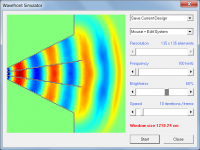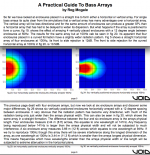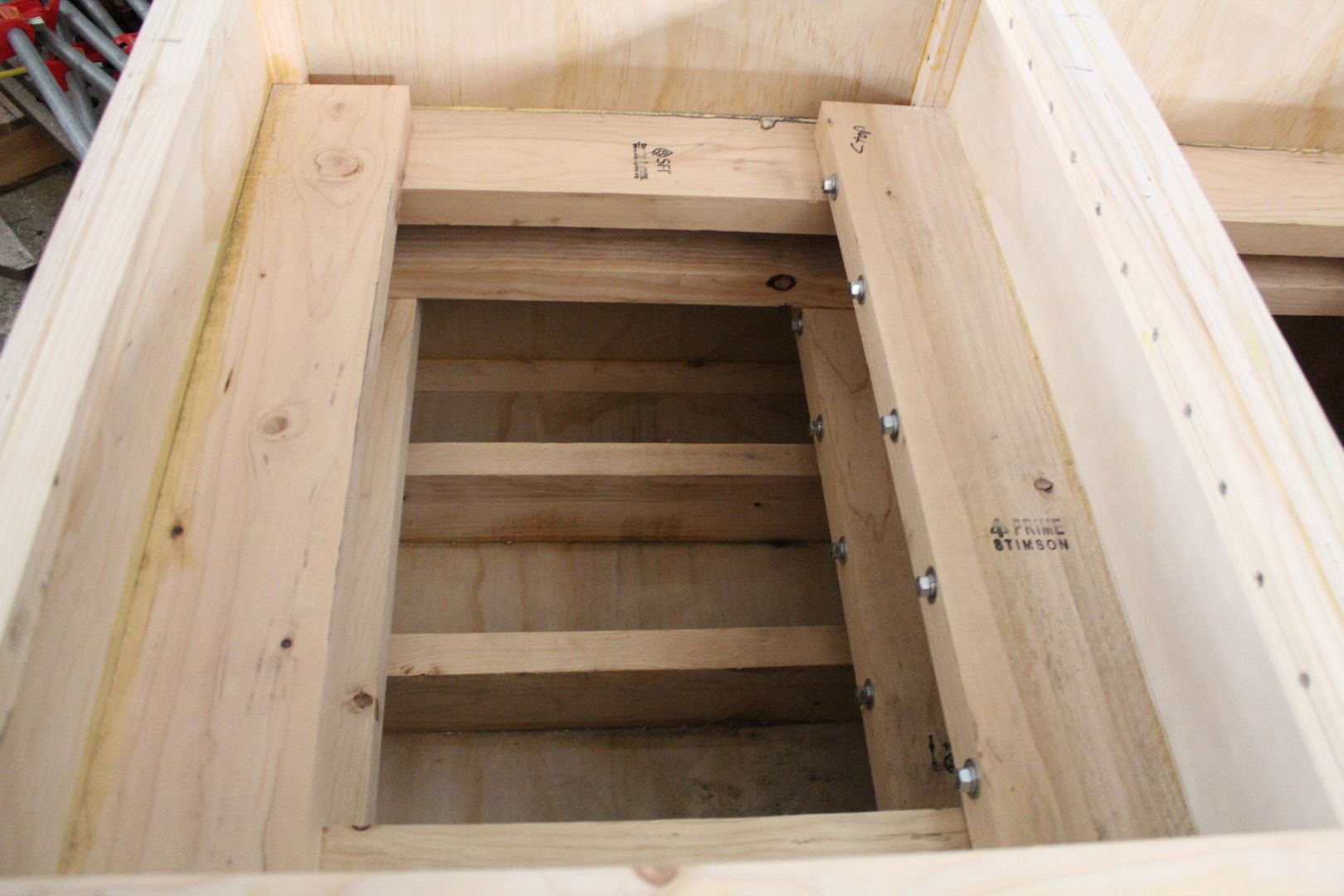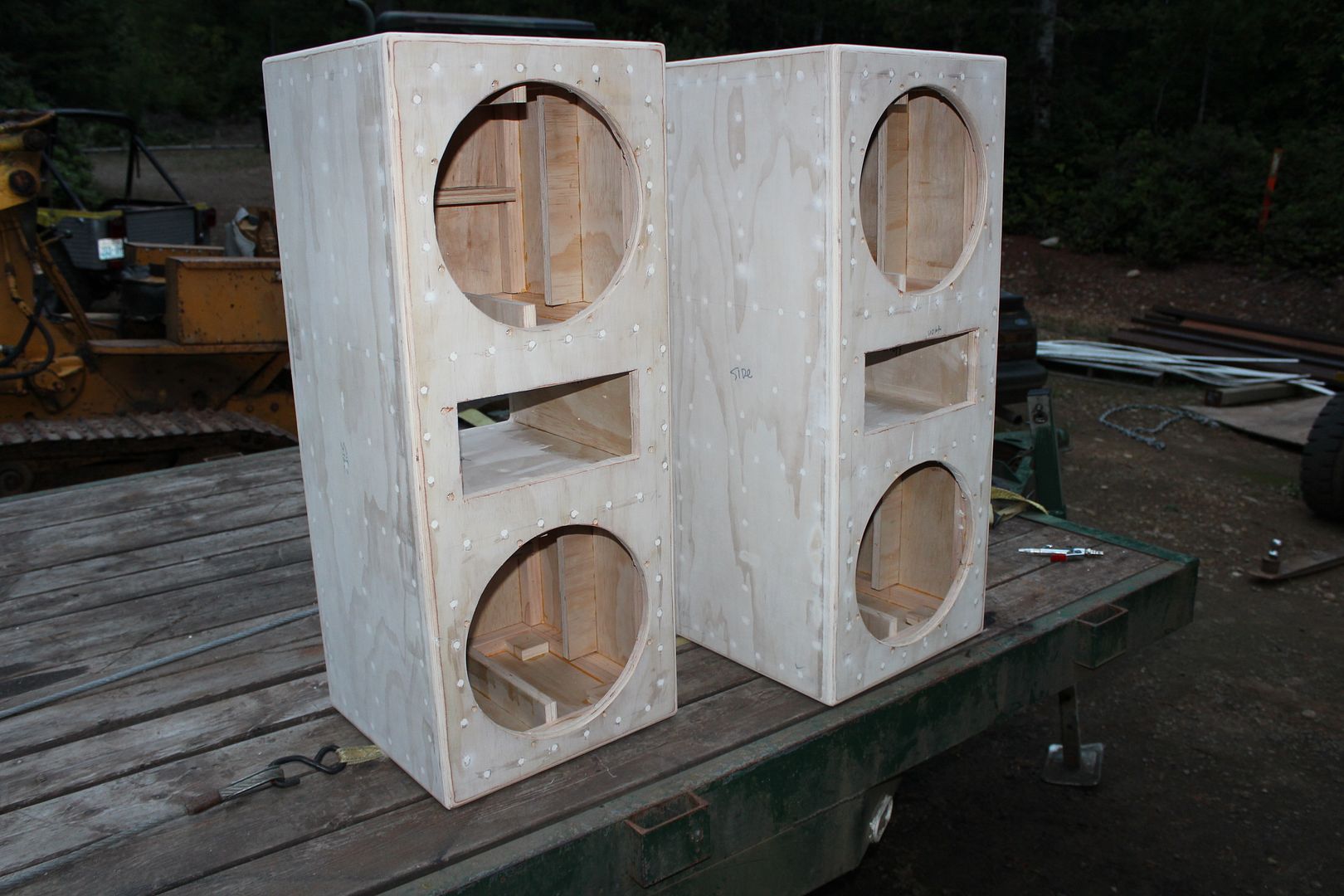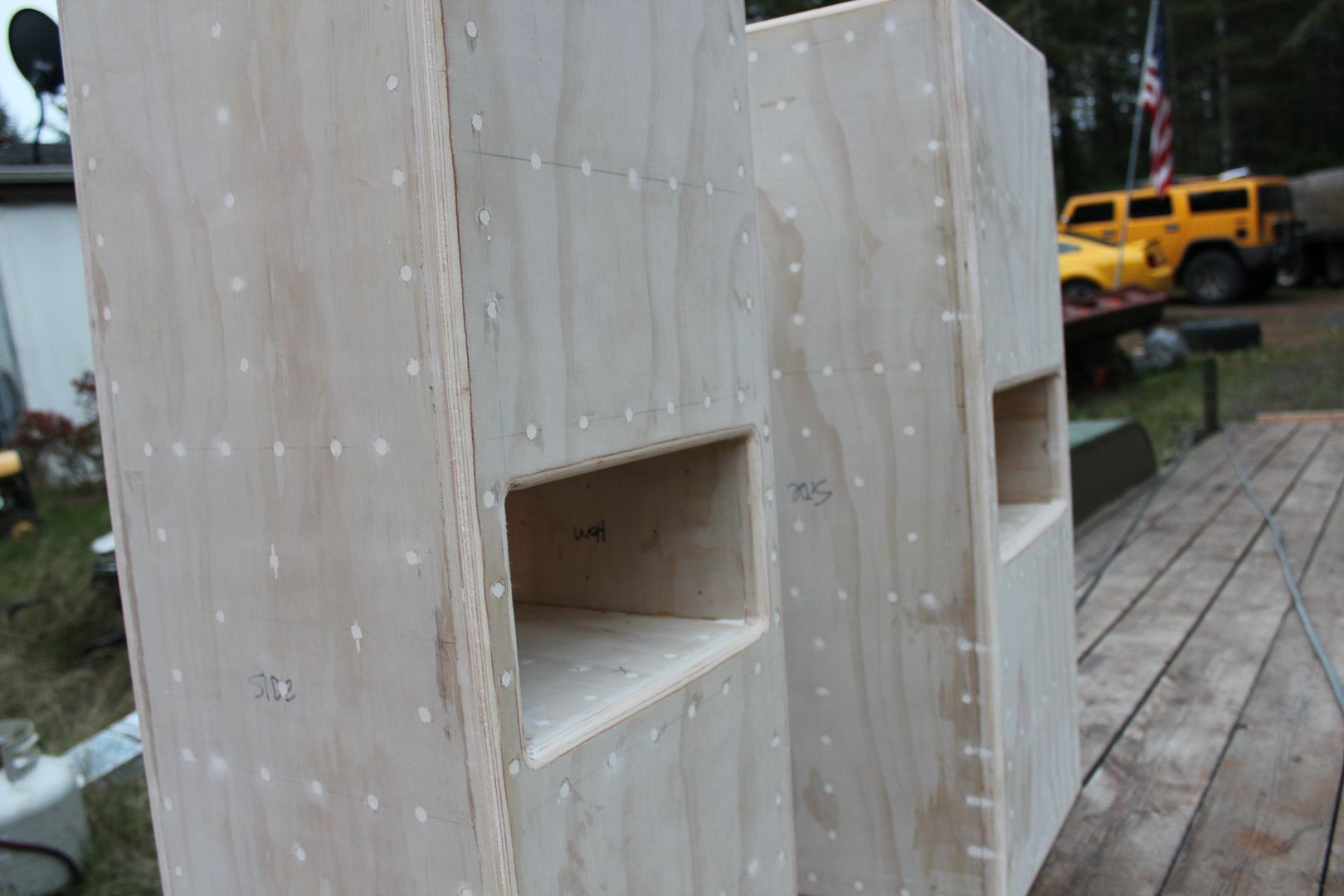why is this thread still going? at this point it's all moot.
dollars to donuts no incarnation of any of this gets built.
dollars to donuts no incarnation of any of this gets built.
One thing practically every horn design reference has in common, is that parallel surfaces inside a horn are bad. . . .
This is a truism, I've seen published/posted that parallel flat surfaces need to be sloping at > either ~6 or 12 degs included for 'slap echo' to rapidly decay. With no way AFAIK to measure it way back when I was actively building, I used 12 degs to err on the safe side as I fought/failed to satisfy my ears dealing with the 210/211 horn's parallel walls: https://www.google.com/search?q=alt...X&ved=0ahUKEwjP1tjcvMXQAhWC4CYKHR1tDTkQsAQIGg
GM
why is this thread still going?
These types of threads are good tutorials 'as is' in so many ways, so stands alone whether it gets built or not. Kind of like you go to a bar brawl and a hockey game eventually breaks out. 😉
GM
Concur
This thread is far too contentious to be worthy of my further participation. It has attitudinal red flags waving all over it. If the OP was a prospective client of mine, he would not be after the first planning meeting. I learned a long time ago, there is some business best left to competitors, because it will be patently unprofitable and replete with other aggravations as well. There are some you will encounter who design there questions to serve as Trojan Horses. WHG
why is this thread still going? at this point it's all moot.
dollars to donuts no incarnation of any of this gets built.
This thread is far too contentious to be worthy of my further participation. It has attitudinal red flags waving all over it. If the OP was a prospective client of mine, he would not be after the first planning meeting. I learned a long time ago, there is some business best left to competitors, because it will be patently unprofitable and replete with other aggravations as well. There are some you will encounter who design there questions to serve as Trojan Horses. WHG
why is this thread still going? at this point it's all moot. dollars to donuts no incarnation of any of this gets built.
Just-a-guy gave 10:1 odds it doesn't get built. I doubt he'd follow through on a bet though - considering I could wager 2 grand, and he'd essentially be paying for my horns.. . .
My wife is a degreed Mechanical Engineer also (we met in college) - a tidbit of information I've been intentionally withholding from this thread. I already catch enough flack from people for being an engineer, and knowing my wife is one too really pi$$es some people off. . . . I'm telling you this, because folks continue to get hung up on the project cost. This project is within our budget. It will cost less than a new car, and last for 50 years. Also, considering that my wife is already talking about landscaping around the horns - this project is likely become a reality.
Are you willing to wager your dollars, for my doughnuts? What if I eat some doughnuts? Does that change the odds? At work, when someone forgets their badge, or when someone get's recognition from management for doing a really good job, it's called a doughnut offense - where the person needs to bring in doughnuts. . . . Doughnuts cost money, so it's sorta like dollars to doughnuts. . . . Can you make a recommendation as to how I may build a better set of horns?
This thread is far too contentious to be worthy of my further participation.
At least post your sketch? I'd like to see your suggested horn dimensions, and wall contours.
Are you worried that if you post your ideas, that weltersys will light into you? He might - - - I certainly will not. . . ..
Sure!
By its very nature, a low frequency horn over most of its length will have near parallel walls. As [Fc] -> 0 the geometry of a tube is approached. Once wavelength becomes comparable the transvers dimensions you will get standing wave modes irrespective of whether the walls are parallel or not. Horns should be treated as band-pass devices where you are trading bandwidth for efficiency. WHG
This is a truism, I've seen published/posted that parallel flat surfaces need to be sloping at > either ~6 or 12 degs included for 'slap echo' to rapidly decay. With no way AFAIK to measure it way back when I was actively building, I used 12 degs to err on the safe side as I fought/failed to satisfy my ears dealing with the 210/211 horn's parallel walls: https://www.google.com/search?q=alt...X&ved=0ahUKEwjP1tjcvMXQAhWC4CYKHR1tDTkQsAQIGg
GM
By its very nature, a low frequency horn over most of its length will have near parallel walls. As [Fc] -> 0 the geometry of a tube is approached. Once wavelength becomes comparable the transvers dimensions you will get standing wave modes irrespective of whether the walls are parallel or not. Horns should be treated as band-pass devices where you are trading bandwidth for efficiency. WHG
By its very nature, a low frequency horn over most of its length will have near parallel walls. As [Fc] -> 0 the geometry of a tube is approached. Once wavelength becomes comparable the transvers dimensions you will get standing wave modes irrespective of whether the walls are parallel or not. Horns should be treated as band-pass devices where you are trading bandwidth for efficiency. WHG
What are you saying? That parallel walls are ok?
Revised comment for post 1060: “The biggest potential issue I see with building - - - is that I’ll have parallel horn walls at X = 125, and practically every horn design reference says that parallel surfaces inside a horn are bad. . . .”
By its very nature, a low frequency horn over most of its length will have near parallel walls.
Horns should be treated as band-pass devices where you are trading bandwidth for efficiency. WHG
More truisms, but we were talking about dealing with the initial throat expansion where we normally don't want to 'upset the applecart' too much, so with him wanting to do like the pioneers and use a 500 Hz XO it will matter, though of course if he's changed this during my absence and it's now only going to be used for to 2-3 octaves like normally done with 'subs' nowadays, then it's a moot point.
GM
I am using four radially dispersed straight stem walls in the vertical plane
Attachments
I’ll have parallel horn walls at X = 125
Horn duct height is approximately 45 cm at X = 125.
45 cm is half a wavelength at around 380 Hz.
picture
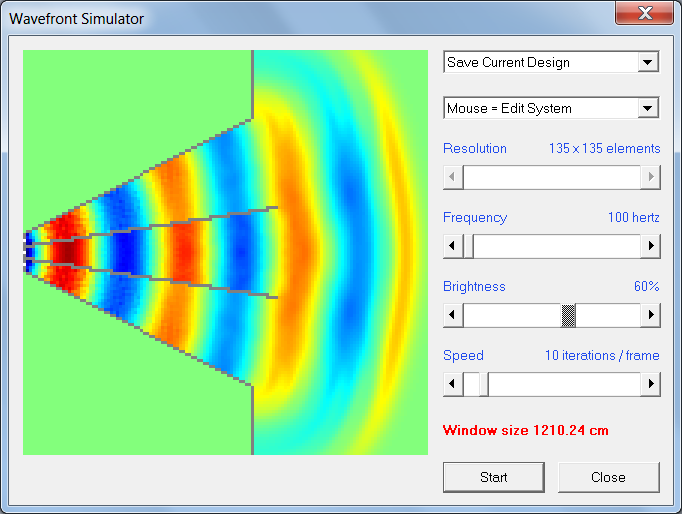
What exactly are we looking at here? It looks like three horns, with the throats converging to a common vicinity - resulting in a convex curvature of the horn mouths. This seems to produce a pretty nice combined wave front – and happens to be the exact opposite of “toe-in” (heh weltersys?) Page 7 of the below link, also supports a convex horn configuration. . . .
http://www.voidaudio.pl/attachments/article/147/A Practical Guide To Bass Arrays (angielski).pdf
And the convex wall clearly produces a better wave front than a straight wall. . . .
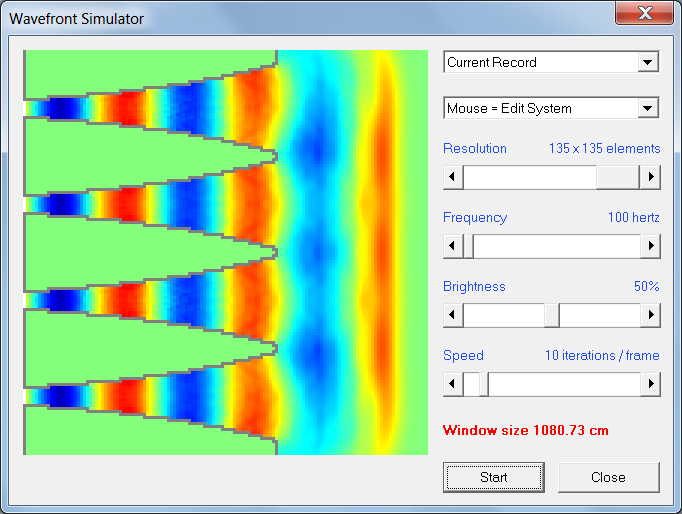
So the real question is, if a convex wall is good for three horns, will it also be good for four horns??? I must admit, I like the idea of having all four horn throats in near vicinity to each other - it means I only need to build a small outbuilding behind the horns. . . Perhaps I can use conical (straight) vertical walls, and incorporate a curved exponential profile into both the horn floor, and the horn overhead. Hmmmm . . . . .
Last edited:
1) Rog Mogale clearly states on page 5 of his "Practical Guide To Bass Arrays":Void Audio's Practical Guide To Bass Arrays by Rog Mogale
(1) Page 5 & Page 6 of the above link clearly show that your recommendation to toe in my horns, was in fact a bad recommendation.
(2) Comparing page 16 with page 8 of the above link, clearly shows that side-by-side placement of LF audio sources will minimize comb filtering, and not maximize it. I can only assume (seeing as you claim to be a sound-reinforcement professional) that you’re intentionally trying to mislead me - again – simply because I refuse to pay you a consultant fee - for your input on a DIY audio website. . . .
3)I ask about horn placement, and you ask me the color of my mustang??? (If you'd been paying attention to post #765, you’d already know. . . .)
4)A more relevant question would be to ask whether or not I’m going to add a coloring agent to the concrete mix. A really dark brick-red would be cool for the horns, with an a grayish-black for the retaining wall. . .
5)Seriously weltersys - either contribute to this thread in a constructive fashion, or please go away. . . .
6)Just-a-guy gave 10:1 odds it doesn't get built. I doubt he'd follow through on a bet though - considering I could wager 2 grand, and he'd essentially be paying for my horns.. . .
7)My wife is a degreed Mechanical Engineer also (we met in college) - a tidbit of information I've been intentionally withholding from this thread.
8)I'm telling you this, because folks continue to get hung up on the project cost. This project is within our budget. It will cost less than a new car, and last for 50 years.
9)Are you willing to wager your dollars, for my doughnuts?
10)What if I eat some doughnuts?
11) Does that change the odds?
12) Can you make a recommendation as to how I may build a better set of horns?
13)Are you worried that if you post your ideas, that weltersys will light into you? He might - - - I certainly will not. .
(reprints of page 5 & 6 attached below)
"So far we have looked at enclosures placed in a straight line to form either a horizontal or vertical array .For single bass arrays it's quite clear from the simulations that a vertical array has many advantages over a horizontal array.
The vertical array will be less directional and for the same amount of enclosures can produce a greater SPL than a horizontal array that has had to be delayed to widen it's dispersion."
Rog's page's 5 and 6 of his "Practical Guide To Bass Arrays" is in complete agreement of every bit of advice I have given you.
This is not Rog nor my "first rodeo" in the horny world of "Bass Arrays" and if you take off your asshat and put on the "dunce cap", sit in the corner and read his practical guide rather than let your "inner troll" advise you, you might actually start to learn something, rather than posture your cement thoughts endlessly across the universal chasm of knowledge and ignorance of it.
Eric, you are obviously able to read and write, when you show some comprehension skills, we might carry on a meaningful dialog, rather than your ignorance of the factual information you cited from Rog Mogale.
Rog is much more used to dealing with the behavior of his primary chosen cliental, dance clubs, and the "DJs" that are the "talent" in said dance clubs that used to be referred to as "Discotheques", or "Discos" for short, back in the age when DJs did more than hit "play" on a setlist they prepared before showing up, and then proceed to masturbate or collect the money while the "Disco" turns around, generation after generational loss.
On the other hand, the hand that holds our "collective soul", I prefer dealing with live bands that can "shake that thing" and make us "feel alright", like Ray Charles or the Red Hot Chili Peppers, who used to perform with nothing but their socks covering their Red Hot Chili Peppers on their encores, and engineers like Dave Rat, who has mixed them since those halcyon days that your "20Hz Concrete Bass Horn Design Question" post made me recall.
2) See answer #1, when I handed your butt to you back on the disco you served it on, and explained the head-ware you should purchase.
3)I have not paid attention to the color of your Mustang you posted 200 some odd posts back, or the horn color you might choose, I am more interested in accurate reproduction of sound, something that is obviously quite low on your agenda.
4) Obviously, color choices are of primary impotence in audio design...
5) I have attempted to make only constructive contributions, but you have seemingly the same cognitive abilities of your preferred building materials.
Like my dead associate from up in the Pacific Northwest Dan Hicks wrote: How Can I miss you when yo won't go away?".
I am here, Eric, where are you?
Seems it is a dark place, and you might have difficulty finding it with a flashlight, so I'll just reiterate my previous advice-read and learn.
And one more bit of advice for any person that actually wants to learn- it is impossible to hear everything the teachers say if you endlessly babble bubbling pablum from your mouth hole during the lessons you are unwilling to learn.
6) I don't give a flying eff through a rolling doughnut what a JAG-off troll would bet, although his order of magnitude bet was predicated on building an audio system, not a concrete Idol.
7) Last night at the Thanksgiving get together, was lucky to associate with two young aspiring mechanical engineers still in school, and a government certified mechanical engineer familiar in the certification of nuclear facilities last night.
The three engineers were unable to correlate their extensive knowledge of theory to audio until I explained it in terms they could relate to, and then the collective "light bulbs" started to glow, though the elder certified mechanical engineer would not answer any of my questions regarding atomic energy, as that information is "classified".
Don't understand why you "withheld" that your wife is a mechanical engineer.
What does being a mechanical engineer or a concrete installer have to do with audio engineering?
8)I'm not at all "hung up" on the cost of your project, if I cared to, I could afford to have you build me a dozen or more concrete Idols.
I would not choose to waste my money investing in such trivial pursuits, but you and your wife are welcome to allocate your assets in any "fashion" that suits your aesthetics.
9) See #6, if a 6 turns out a 9, I don't mind, I don't mind (Jimi Hendrix quote, used to live up by you Eric, but unfortunately he died).
10) Whatever, you might develop coronary problems, you might get a pot-belly, or you might be like Jeff Goldblum in "The Fly", and continue to regurgitate the doughnuts before digesting them.
11)Everything you post seems at odds with achieving any audio goals.
12) You repeat yourself yet again, like "Deja Vu all Over Again", an endless recursive reverse-Socratic time loop.
13) William and I seldom disagree, we both have actually built and listened to horns for decades. Mr. Geiger and I both agree you are quite disagreeable.
All the best in your swift recovery, and condolences to your mechanical engineer wife.
Art
Attachments
Last edited:
Hi Entropy455,
I was trying to illustrate one advantage of using Bill's suggested layout. In theory, the isophase wavefronts leaving the three horn mouths will be entirely coherent. The slight differences shown in the simulation results are due to the three sources being aligned in the same plane. In reality, the drivers in the two outer horns would be normal to their horn axes, resulting in perfectly coherent combined wavefronts being generated by the three horn system at low frequencies where beaming is not a factor.
That's what I was hoping to demonstrate 🙂.
Even better, I suspect 🙂.
For one thing, the frequency at which beaming becomes an issue should be higher.
Note however, that with Bill's proposal the two stereo signals are in effect being directed slightly "outwards" from the on-axis listening position. Art's alternative "toe-in" proposal avoids this.
Decisions, decisions...
Kind regards,
David
What exactly are we looking at here? It looks like three horns, with the throats converging to a common vicinity - resulting in a convex curvature of the horn mouths.
I was trying to illustrate one advantage of using Bill's suggested layout. In theory, the isophase wavefronts leaving the three horn mouths will be entirely coherent. The slight differences shown in the simulation results are due to the three sources being aligned in the same plane. In reality, the drivers in the two outer horns would be normal to their horn axes, resulting in perfectly coherent combined wavefronts being generated by the three horn system at low frequencies where beaming is not a factor.
And the convex wall clearly produces a better wave front than a straight wall. . . .
That's what I was hoping to demonstrate 🙂.
So the real question is, if a convex wall is good for three horns, will it also be good for four horns???
Even better, I suspect 🙂.
For one thing, the frequency at which beaming becomes an issue should be higher.
Note however, that with Bill's proposal the two stereo signals are in effect being directed slightly "outwards" from the on-axis listening position. Art's alternative "toe-in" proposal avoids this.
Decisions, decisions...
Kind regards,
David
David,Note however, that with Bill's proposal the two stereo signals are in effect being directed slightly "outwards" from the on-axis listening position. Art's alternative "toe-in" proposal avoids this.
Decisions, decisions...
Kind regards,
David
Eric obviously "missed the boat" that my alternative (alternative to a troll's endless suggestion of a mono central sub location) "proposal" with a "toe-in" equal to that of the upper frequency horns, a half millennia of posts ago, was for a pair stereo bass horns, not an "array" of bass horns, unless the horns are vertically arrayed as I suggested in countless posts, and Rog suggested in his "Void Audio's Practical Guide To Bass Arrays" paper that Eric thought was proof I was trying to "torpedo" his thread, hoisted on his own "piturd".
Like Tom Petty quoted; "Damn the torpedoes, full speed ahead!"
Or "Two steps forward, Three steps back"- pretty soon you are consumed by the heat in the engine room following those orders from the bow.
Kinda regardless,
Art
Last edited:
Makes No Difference
David,
1) So long as the radiation pattern is uniform over the coverage angle for the frequencies of interest, a small toe-out makes no difference. If the horn was operated in an enclosure that would be a different story over the entire pass-band.
2) What is being over looked here is the need for a center channel particularly for the satellite units to cover center stage vocals and solo instrumental performances.
3) By far satellite unit design will be less forgiving than that of the sub-bass horn. I want to see the OP spend more of his budget here, where differences will be easy to hear. In this outdoor setting the system will be working into an anechoic environment where reverberant masking is not going to be taking place. Here small driver/horn imperfections will be easy to detect. Also to get the same SPL to the listing position requires more acoustic energy because none is being reflected off enclosing walls and ceiling back into this area.
4) The use DSP for driver/horn voicing, time/phase alignment, and level balancing is essential to delivering top flight system performance. Without it, it does not matter how much concrete gets poured, or how much is spent on drivers and power amplifiers.
5) A dry signal may not be pleasing on some program material. Recommend a good effects processor be incorporated into the system as well.
6) The system the OP plans on building when completed will be an acoustic first. As far as I know, no-one has built a horn system this large before, particularly out of concrete.
Regards,
Bill
Hi Entropy455,
I was trying to illustrate one advantage of using Bill's suggested layout. In theory, the isophase wavefronts leaving the three horn mouths will be entirely coherent. The slight differences shown in the simulation results are due to the three sources being aligned in the same plane. In reality, the drivers in the two outer horns would be normal to their horn axes, resulting in perfectly coherent combined wavefronts being generated by the three horn system at low frequencies where beaming is not a factor.
That's what I was hoping to demonstrate 🙂.
Even better, I suspect 🙂.
For one thing, the frequency at which beaming becomes an issue should be higher.
Note however, that with Bill's proposal the two stereo signals are in effect being directed slightly "outwards" from the on-axis listening position. Art's alternative "toe-in" proposal avoids this.
Decisions, decisions...
Kind regards,
David
David,
1) So long as the radiation pattern is uniform over the coverage angle for the frequencies of interest, a small toe-out makes no difference. If the horn was operated in an enclosure that would be a different story over the entire pass-band.
2) What is being over looked here is the need for a center channel particularly for the satellite units to cover center stage vocals and solo instrumental performances.
3) By far satellite unit design will be less forgiving than that of the sub-bass horn. I want to see the OP spend more of his budget here, where differences will be easy to hear. In this outdoor setting the system will be working into an anechoic environment where reverberant masking is not going to be taking place. Here small driver/horn imperfections will be easy to detect. Also to get the same SPL to the listing position requires more acoustic energy because none is being reflected off enclosing walls and ceiling back into this area.
4) The use DSP for driver/horn voicing, time/phase alignment, and level balancing is essential to delivering top flight system performance. Without it, it does not matter how much concrete gets poured, or how much is spent on drivers and power amplifiers.
5) A dry signal may not be pleasing on some program material. Recommend a good effects processor be incorporated into the system as well.
6) The system the OP plans on building when completed will be an acoustic first. As far as I know, no-one has built a horn system this large before, particularly out of concrete.
Regards,
Bill
Last edited:
I hope you'll hang around since you are one of the few posters who knows what they are talking about....The use DSP for driver/horn voicing, time/phase alignment, and level balancing is essential to delivering top flight system performance. Without it, it does not matter how much concrete gets poured, or how much is spent on drivers and power amplifiers.
5) A dry signal may not be pleasing on some program material. Recommend a good effects processor be incorporated into the system as well.
6) The system the OP plans on building when completed will be an acoustic first. As far as I know, no-one has built a horn system this large before, particularly out of concrete.l
You talk about quality sound which ordinarily is what all of us seek. And you mention SYSTEM DESIGN issues that matter.
But OP has been clear he just wants something like he heard in a ballpark once when he heard the Billy-Berries and he slips out of quality with that "criterion". Never the less, he and everybody else argue endlessly about issues of totally minute sonic significance like toe-in in order to design the five-decimal-place perfect horn to play an audio range with virtually no recorded content available.
These types of threads are good tutorials 'as is' in so many ways, so stands alone whether it gets built or not. Kind of like you go to a bar brawl and a hockey game eventually breaks out. 😉
Respectfully, all this naval gazing (I am too timid to use more adult anatomic locations) is quite useless unless something is built AND MEASURED. Pretty clear Eric is going to welsh on that bet since he hasn't so much as hassled his rump to bring a speaker out of doors for initial testing. He isn't serious except at the keyboard.
Remember the organ speaker thread that continued endlessly and the builder didn't have the decency to post results? Some may think abstract debates about my sim is prettier than your sim are swell, but doesn't pass my science sniff test.
Ben
Last edited:
...unless the horns are vertically arrayed as I suggested in countless posts...
You suggest that I turn my horns on their side, and build 8 feet wide, 32 feet tall concrete horns? In a Class II earthquake zone? Who's wearing the dunce-cap now weltersys??? Seriously, go away. . . .
2) What is being over looked here is the need for a center channel particularly for the satellite units to cover center stage vocals and solo instrumental performances.
4) The use DSP for driver/horn voicing, time/phase alignment, and level balancing is essential to delivering top flight system performance. Without it, it does not matter how much concrete gets poured, or how much is spent on drivers and power amplifiers.
5) A dry signal may not be pleasing on some program material. Recommend a good effects processor be incorporated into the system as well.
6) The system the OP plans on building when completed will be an acoustic first. As far as I know, no-one has built a horn system this large before, particularly out of concrete.
(2) I don't know any bands, nor do I own any live mixing equipment. The odds of live music being played at my house are extremely low. My primary signal source will be CD recordings (digital files). A while back, a recommendation was made to introduce a center channel & some rear channels, and install a large screen above the horns. I must admit - this would make for a pretty cool movie watching setting. I’m still open to this idea. For a THX type application, I could switch the horns over to play as a mono sub, and turn on the center channel & surrounds. For playing music, I could switch the bass horns back to stereo, and simply shut off the center channel & surrounds. Who knows – maybe it would still sound good with the center channel running???
(4) Unless I find something better (at reasonable cost), I’m looking at purchasing DSS Soundweb delays & crossovers.
(5) Ben said the same thing. I purchased a DBX Aural exciter long ago, and I still really like it. If the sound is too dry, I will absolutely add moisture. .. . Maybe not necessarily with the DBX, but I’m open to signal conditioning. (I’ve been told by the purists that effects processors are cheating. . ..)
(6) Strange, right? Almost every old audio reference (with a chapter on horn design) talks about how awesome “rigid” full size horns are. I’m assuming the authors are not speculating on how awesome they sound – that they’ve actually heard one??? One would think there’d be at least several dozen full size rigid horns in existence - within the US alone. . . .
Pretty clear Eric is going to welsh on that bet since he hasn't so much as hassled his rump to bring a speaker out of doors for initial testing. He isn't serious except at the keyboard. Ben
The purpose of taking the wife’s speakers outside, was to listen to for bass lobing at a 60-ft stereo separation. Just-a-guy has shown (as well as multiple other recognized sound reinforcement publications) that a 60-ft stereo separation is a really bad idea – particularly at low frequencies. Thus the outdoor test is a moot point. Additionally, there is no value added my pretending two 30 Hz bass-reflex enclosures, are (qty 4) giant 15 Hz straight exponential bass horns. It’s like test driving a lawnmower, to see how a lotus will handle. . .
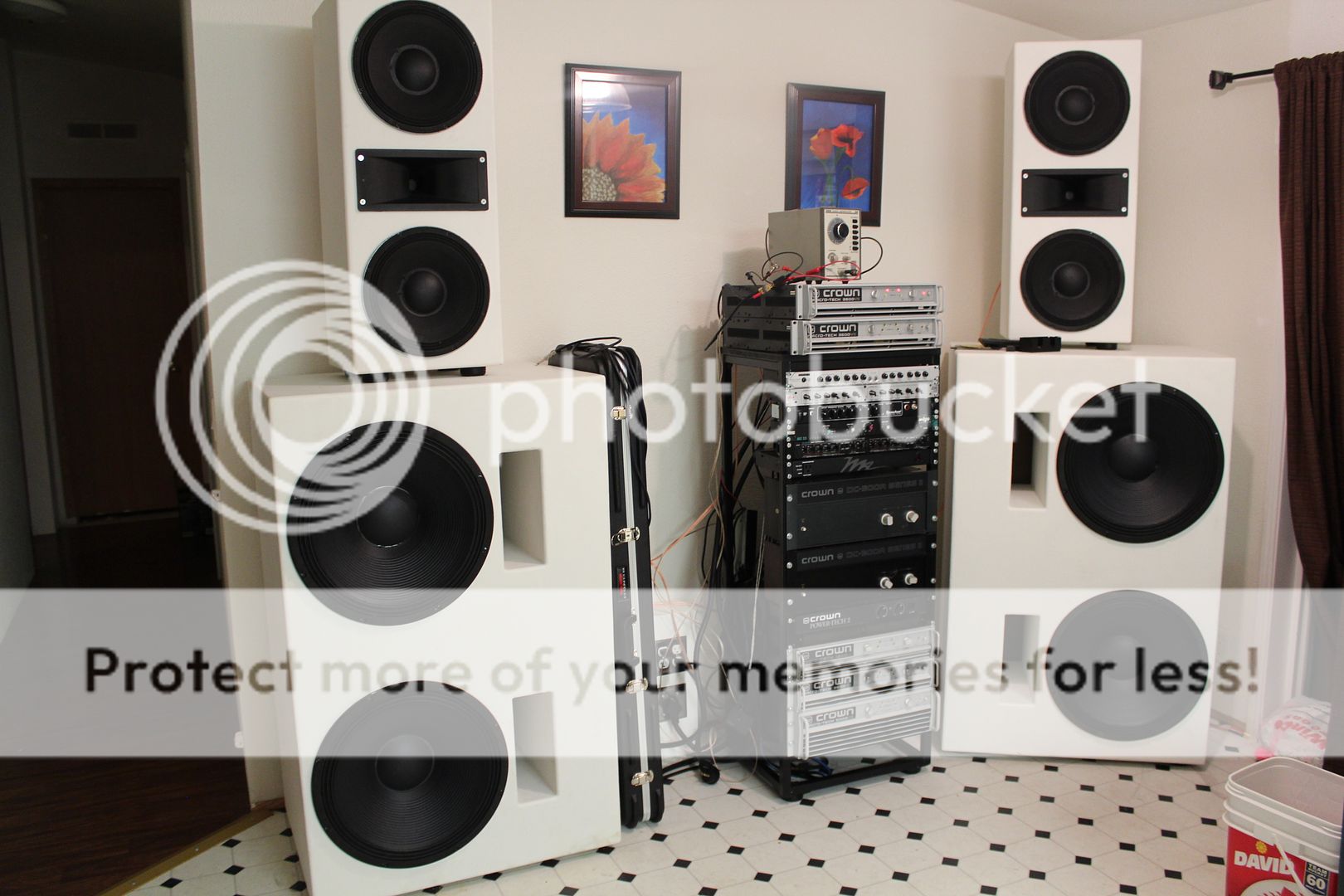
Last edited:
There are always ten-million logical-appearing reasons for not getting off your rump and doing some reality testing.*
Ben
*must be something they put in the water fountains in engineering schools
Ben
*must be something they put in the water fountains in engineering schools
- Home
- Loudspeakers
- Subwoofers
- Concrete Bass Horn Design Question
